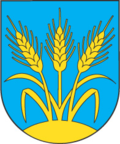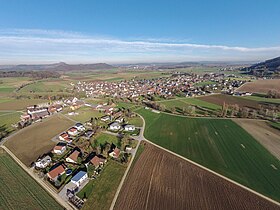Ramsen SH
| SH is the abbreviation for the canton of Schaffhausen in Switzerland and is used to avoid confusion with other entries of the name Ramsen . |
| Ramsen | |
|---|---|
| State : |
|
| Canton : |
|
| District : | stone |
| BFS no. : | 2963 |
| Postal code : | 8262 |
| UN / LOCODE : | CH RAM |
| Coordinates : | 702 899 / 285069 |
| Height : | 413 m above sea level M. |
| Height range : | 393–680 m above sea level M. |
| Area : | 13.50 km² |
| Residents: | 1469 (December 31, 2018) |
| Population density : | 109 inhabitants per km² |
| Website: | www.ramsen.ch |
|
Ramsen SH |
|
| Location of the municipality | |
Ramsen is a municipality in the canton of Schaffhausen in Switzerland .
geography
Ramsen is located in the Bibertal directly on the German border and has an area of 1345 ha. In addition to the village, it consists of the hamlets Bibermühle , Hofenacker , Moscow , Wiesholz and Wilen.
In addition to the hamlet of Moscow, there are also the field names Petersburg and on the edge of the forest to the Rauhenberg "Chlii Amerika" (Little America).
The Biber river flows through the village and flows into the Upper Rhine below Stein am Rhein .
history
Ramsen was first mentioned in 846. In the Middle Ages the village belonged to the Habsburg Landgraviate of Nellenburg . In 1539, the lesser jurisdiction passed from the Lords of Klingenberg to the city of Stein am Rhein , which was under the authority of Zurich . Zurich finally acquired blood jurisdiction over Ramsen in 1770 . In 1798 Ramsen came to the canton of Schaffhausen together with Stein in the course of the Helvetic Republic. Ramsen as a border town was the end point of the Singen escape route during World War II , an escape route for Dutch and British prisoner-of-war officers who found their way from the Colditz Castle prison camp in Saxony via Singen to Switzerland. A little later it was an important entry point for refugees who were housed in the Catholic Church and in the Schüppelwald.
population
On December 31, 2011, Ramsen had 1,345 inhabitants, 848 of whom were eligible to vote, 195 students and 242 foreigners.
Economy and Transport
Ramsen's economy is characterized by the immediate border location, which explains the above-average number of transport companies and petrol stations. The most important employers are customs and the software company Star AG . The shortest route from Ramsen to Schaffhausen is via Gailingen am Hochrhein and Büsingen am Hochrhein and crosses the international border with Germany four times. Ramsen can be reached by public transport with a bus line from Südbadenbus from Stein am Rhein via Ramsen to Singen and with line 25 from SchaffhausenBus every hour to Schaffhausen via Buch- Murbach- Randegg - Dörflingen .
The community received its own train station on July 17, 1875, when the Swiss National Railway (SNB) opened the Etzwilen – Singen line. After the bankruptcy of the SNB, the line was taken over by the Schweizerische Nordostbahn (NOB) and eventually came into the possession of the Swiss Federal Railways (SBB) when it was nationalized . On May 31, 1969, they stopped passenger traffic on the route. The line was used as a freight line until 2004 and was ultimately the last non-electrified line of the SBB. With the decision to handle all freight traffic between Winterthur and Singen via Schaffhausen, the line was definitely downgraded to an industrial track. After the closure, the line was not dismantled, but taken over by the Association for the Preservation of the Etzwilen-Singen Railway Line , which has been using it for trolley and steam rides since 2007 .
Culture
Ramsen has a lively club life, which manifests itself in many events and festivities throughout the year. The most outstanding events include the annual performances of the “Theater 88”, as well as the “Turner-Chränzli” (gymnastics festival). The largest club is the soccer club , whose 1st team plays in the 4th league. The Catholic past has given rise to a carnival tradition in Ramsen, one of the few places in the canton of Schaffhausen, with a street parade , masked ball and schnitzel bank (Bänkelsang) .
coat of arms
- Three yellow ears of wheat growing from a yellow shield base in blue.
In 1810 a coat of arms of the municipality of Ramsen was found on a seal for the first time. It shows three ears of wheat growing out of the ground. During the adjustment in 1949, an attempt was made to create a historical connection by combining the coat of arms symbol with that of the Landgraviate of Nellenburg , in which Ramsen was located. However, the community assembly rejected this proposal.
Buildings, sights
The village of Ramsen has two parish churches, the Catholic parish church of St. Peter and Paul and the Reformed parish church of Ramsen .
Personalities
- Elise Höfler (1912–1991), Swiss-German Righteous Among the Nations
- Joseph Gnädinger (1919–2000), painter
- Leonhard Neidhart (* 1934), political scientist
- Mathias Gnädinger (1941–2015), actor
- Angelo Gnädinger (* 1951), General Director of the Red Cross
- Joseph Jung (* 1955), historian
gallery
District Moscow SH on June 16, 2006
literature
- Municipality of Ramsen (ed.): Ramsen. Homeland book. Published for the 1150th anniversary of the Ramsen community. Ramsen 1996, ISBN 3-9521-139 .
- Gregor Schweri: The rule of Ramsen in the 16th and 17th centuries (1539-1659). Freiburg 1974.
- Christian Birchmeier among others: Buch, Ramsen, Hemishofen. In: Schaffhauser Magazin. 27, 2004, No. 2, pp. 5-37.
Web links
- Official website of the municipality of Ramsen
- Matthias Wipf: Ramsen. In: Historical Lexicon of Switzerland .
Individual evidence
- ↑ Permanent and non-permanent resident population by year, canton, district, municipality, population type and gender (permanent resident population). In: bfs. admin.ch . Federal Statistical Office (FSO), August 31, 2019, accessed on December 22, 2019 .
- ↑ Swisstopo: Map excerpt
- ^ "Ramsen, end of" The Singen Route "", Steiner Anzeiger of October 18, 2016
- ^ Berty Bruckner-Herbstreit: The emblems of the state Schaffhausen and its communities. Reinach-Basel 1951, pp. 266-268.
- ^ Gnädinger, Josef - SIKART Lexicon on art in Switzerland. In: sikart.ch. Retrieved May 13, 2014 .











